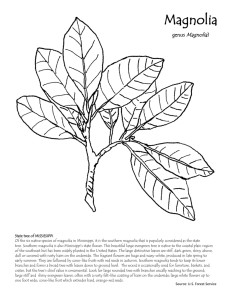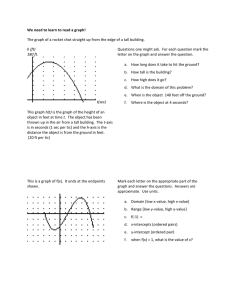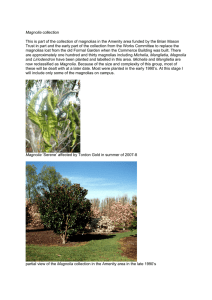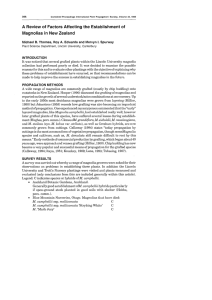S Growing Southern Magnolia Gary L. Wade, Extension Horticulturist Department of Horticulture
advertisement
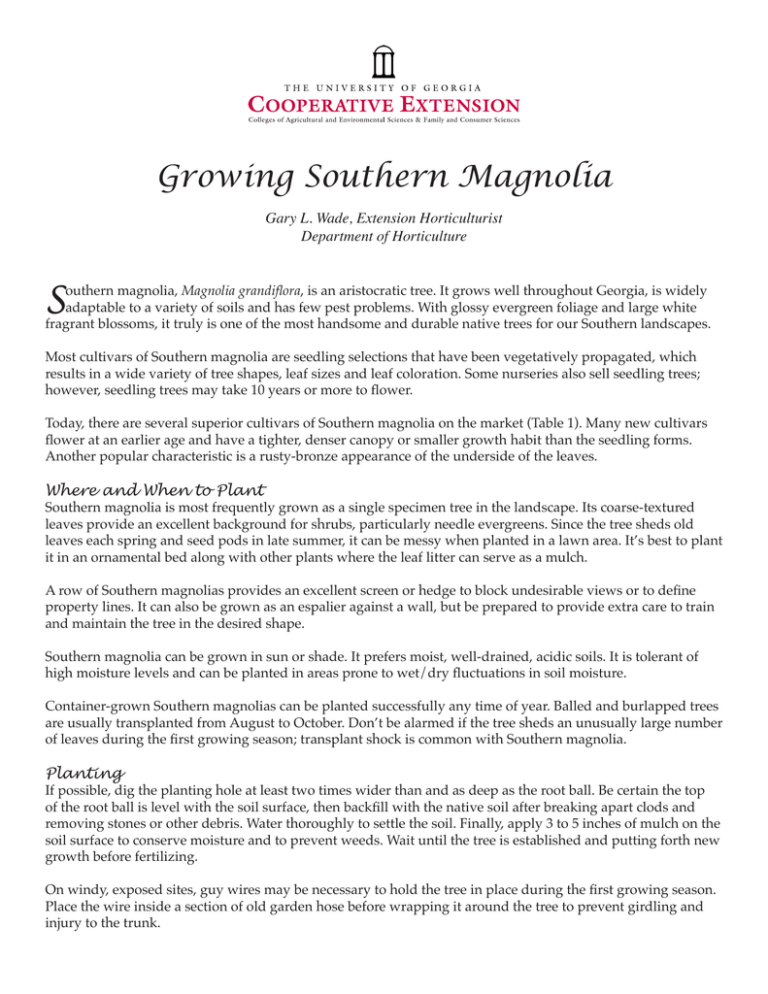
Growing Southern Magnolia Gary L. Wade, Extension Horticulturist Department of Horticulture S outhern magnolia, Magnolia grandiflora, is an aristocratic tree. It grows well throughout Georgia, is widely adaptable to a variety of soils and has few pest problems. With glossy evergreen foliage and large white fragrant blossoms, it truly is one of the most handsome and durable native trees for our Southern landscapes. Most cultivars of Southern magnolia are seedling selections that have been vegetatively propagated, which results in a wide variety of tree shapes, leaf sizes and leaf coloration. Some nurseries also sell seedling trees; however, seedling trees may take 10 years or more to flower. Today, there are several superior cultivars of Southern magnolia on the market (Table 1). Many new cultivars flower at an earlier age and have a tighter, denser canopy or smaller growth habit than the seedling forms. Another popular characteristic is a rusty-bronze appearance of the underside of the leaves. Where and When to Plant Southern magnolia is most frequently grown as a single specimen tree in the landscape. Its coarse-textured leaves provide an excellent background for shrubs, particularly needle evergreens. Since the tree sheds old leaves each spring and seed pods in late summer, it can be messy when planted in a lawn area. It’s best to plant it in an ornamental bed along with other plants where the leaf litter can serve as a mulch. A row of Southern magnolias provides an excellent screen or hedge to block undesirable views or to define property lines. It can also be grown as an espalier against a wall, but be prepared to provide extra care to train and maintain the tree in the desired shape. Southern magnolia can be grown in sun or shade. It prefers moist, well-drained, acidic soils. It is tolerant of high moisture levels and can be planted in areas prone to wet/dry fluctuations in soil moisture. Container-grown Southern magnolias can be planted successfully any time of year. Balled and burlapped trees are usually transplanted from August to October. Don’t be alarmed if the tree sheds an unusually large number of leaves during the first growing season; transplant shock is common with Southern magnolia. Planting If possible, dig the planting hole at least two times wider than and as deep as the root ball. Be certain the top of the root ball is level with the soil surface, then backfill with the native soil after breaking apart clods and removing stones or other debris. Water thoroughly to settle the soil. Finally, apply 3 to 5 inches of mulch on the soil surface to conserve moisture and to prevent weeds. Wait until the tree is established and putting forth new growth before fertilizing. On windy, exposed sites, guy wires may be necessary to hold the tree in place during the first growing season. Place the wire inside a section of old garden hose before wrapping it around the tree to prevent girdling and injury to the trunk. Aftercare Once established, growth can be accelerated with light, frequent applications of fertilizer during the first three growing seasons. During the first growing season after establishment, apply ½ pound (1 cup) of 8-8-8 or 10-1010 fertilizer along the perimeter of the planting hole in March, May and July. The second year, increase the rate of the fertilizer to 2 cups and broadcast it in a donut-shaped area from the tips of the canopy to 3 feet beyond the canopy in March, May and July. By the third year, increase the rate to 4 cups and spread it in a donutshaped area from the tips of the canopy to 6 feet beyond the canopy in March, May and July. By the fourth year, the tree should have a well-established root system and should be able to forage for nutrients on its own. Magnolia roots have been shown to grow more than three times further than the canopy width of the tree, so they can obtain nutrients applied to nearby plants and turfgrass. Southern magnolia is most often grown as a single-trunk tree, but it can also be grown in a multi-trunk form. Begin shaping the plant while it is young by selectively thinning side branches as needed to produce and maintain the desired growth form. In formal landscapes, the tree is sometimes sheared once or twice a season to encourage branching and to maintain a tight, compact form. However, the tree looks best when allowed to grow in a more open, natural form with branching all the way to the ground. Reference Dirr, Michael A. 1998. Manual of Woody Landscape Plants. Stipes Publishing Co. Table 1. Popular Southern Magnolia Cultivars ‘Bracken’s Brown Beauty’ One of the most popular cultivars in the trade, prized for lustrous green leaves with a fuzzy, rusty texture on their undersides. The tree reaches 30 to 50 feet tall and 30 feet wide, so it needs room to spread. It tends to be self-branching and forms a dense canopy. ‘Claudia Wannamaker’ This tree flowers at an early age and has dark green foliage with medium rusty-brown undersides. It is one of the most widely grown cultivars, reaching 50 feet tall and 40 feet wide. ‘D.D. Blanchard’ Leathery, lustrous, dark green leaves with rich, orange-brown undersides. In youth, the tree is more open than ‘Claudia Wannamaker.’ It reaches 50+ feet tall at maturity. ‘Edith Bogue’ Among the most cold hardy of the magnolias. The tight pyramidal form reaches 30 feet tall and 15 feet wide with narrow, lustrous dark green leaves. The loose and open growth habit becomes more dense with age. ‘Greenback’ A selection from Bold Springs Nursery in Monroe, Ga., with lustrous, wavy, dark green leaves and a tight, dense form growing 30 feet tall and 12 feet wide. A good choice for screening. ‘Hasse’ Tight columnar form with lustrous, dark green upper leaf surface with dark brown undersides. Ideal for small spaces and screening. Reaches 40 feet tall and 15 feet wide. ‘Little Gem’ One of the smallest of the magnolias, reaching 30 feet tall and 15 feet wide. Small, dark green leaves are bronze-brown beneath. The tree flowers at a young age. Leaves and flowers are smaller than most other magnolias. A 2000 Georgia Gold Medal Winner. ‘Majestic Beauty’ Extravagantly large plant with large leaves and large, profuse flowers up to 12 inches in diameter. Very little lustrous dark green leaves. The tree reaches 50 feet tall with a spread of 20 feet. ‘Samuel Sommer’ Dark green leaves with a brownish-rust underside. An upright, pyramidal tree growing 40 feet tall and 30 feet wide. Flowers are 10 to 14 inches in diameter. ‘Teddy Bear’ A compact form reaching 20 feet tall and 10 feet wide. Leaves are smaller than most other magnolias, 2 to 4 inches wide and 3 to 6 inches long. They are lustrous green above and fuzzy, rusty brown below. Flowers from May to November. Circular 974 Revised September 2009 The University of Georgia and Ft. Valley State College, the U.S. Department of Agriculture and counties of the state cooperating. Cooperative Extension offers educational programs, assistance and materials to all people without regard to race, color, national origin, age, sex or disability. An Equal Opportunity Employer/Affirmative Action Organization Committed to a Diverse Work Force
